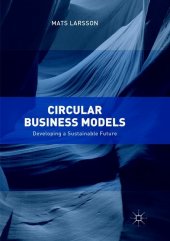 Neuerscheinungen 2019Stand: 2020-02-01 |
Schnellsuche
ISBN/Stichwort/Autor
|
Herderstraße 10
10625 Berlin
Tel.: 030 315 714 16
Fax 030 315 714 14
info@buchspektrum.de |

Mats Larsson
Circular Business Models
Developing a Sustainable Future
Softcover reprint of the original 1st ed. 2018. 2019. xi, 303 S. 14 Farbabb. 210 mm
Verlag/Jahr: SPRINGER, BERLIN; SPRINGER INTERNATIONAL PUBLISHING 2019
ISBN: 3-319-89106-5 (3319891065)
Neue ISBN: 978-3-319-89106-4 (9783319891064)
Preis und Lieferzeit: Bitte klicken
This book explores the need to develop business strategies, organise and fund transformation projects and manage the transformation programme in order to further a circular economy. Circular Business Models outlines sustainable business models that can be used by companies to move transformation forward on a large scale. In addition to business models the book will cover and discuss a number of other factors necessary for a successful transformation, such as business and innovation strategy, entrepreneurship and change management. Including original interviews with circular economy practitioners, this book will be applicable to industries as diverse as manufacturing, food processing, transportation and mechanical engineering. Addressing the different challenges that meet circular economy visionaries, it outlines strategies and business models needed to gain momentum in these different sectors.
1. Mankind vs. Reality. 10
The Science of Problem Solving. 11
References. 12
Part One - Business and Organizational Aspects of Circular Economies. 13
2. Development as a Process of Organization.. 13
The Organization of a Circular Economy. 15
A Development Over a Century. 17
References. 19
3. The Author´s Journey. 20
Earlier Thoughts on Sustainability, Circular Economy, and Transformation.. 21
Sustainability. 21
Circular Economy. 22
Technology Development, Business Transformation, and Peak Oil 23
References. 23
4. The Circular Economy and Business Challenges. 25
Understanding Innovation and Business Development 26
Imminent Threats. 28
Crossing the Chasm - from Idealistic to Demanding Customers. 30
Carbon Dioxide and Global Warming vs. Resource Depletion.. 31
The Experience Curve. 32
References. 33
5. Complexity - The Tightly Woven Fabric of Society. 34
Complexity in Modern Society. 34
The Increasing Specialization in the Linear Economy. 36
Increasing Specialization of the Circular Economy. 37
References. 38
6. Could Resource Shortages Cause Problems?. 39
Complex Development 41
A Development in Steps. 42
Driving Change. 46
A Collaborative Effort 46
A Systems Perspective. 47
References. 47
7. Multiple Helix Collaboration for the Development of a Circular Economy. 48
A Multipe-Helix Innovation System.. 48
The Role of Governments. 49
Research and Training. 51
Non-Government Organizations. 52
Civic Society and the General Public. 53
Company and Public Sector Procurement 54
References. 55
8. Managing Change. 56
Change Management 58
Examples of Roles. 60
Early Phases of Transformation.. 60
The Savings Paradox. 61
Dismantling Obsolete Systems. 63
Mind-Set and Behaviour Change. 64
Leading Through Change. 64
The Resource Based View of Business Strategy. 66
References. 68
Part Two - Challenges by industry and business sector 69
9. Local Production and Distribution Systems. 69
The Current Situation.. 70
Transformation to Local Production and Distribution Systems. 70
The Development of Local Markets. 71
Efficient Systems for Local Production.. 72
Local Value Chains. 73
Local Food Production.. 73
Volume Growth.. 74
Secondary Qualities. 76
The Role of Large Firms. 77
Customers Form Industries. 78
Steps to Change. 78
Step 1: Local Stand-Alone Concepts. 79
Step 2: Local Production and Distribution Concepts. 79
Step 3: Integrated Local Value Chains. 80
Step 4: Volume Competition.. 81
Step 5: Local and Circular Concepts Dominate. 81
Disruptive Aspects of Change. 81
From Global to Local Production and Distribution.. 82
Procurement Strategies. 82
A New Focus. 83
Opportunities for Local Production Offered by Digitalization.. 84
Changing Customer Preferences. 85
Step 1: Indifferent Majority. 86
Step 2: Emerging Preferences. 86
Step 3: Widespread Adoption and Volume Growth.. 86
Step 4: Circular Majority. 87
Step 5: Preferences for Local and Circular Concepts Dominate. 87
References. 87
10. Sharing and Extended Use. 88
The Present Situation.. 88
Sharing Models. 88
Growth Opportunities and Patterns of Use. 90
The Product as a Service. 92
Inexpensive Alternatives. 92
Potential Growth Areas. 92
Integration.. 92
Flow.. 92
High Value. 93
Genuinely Circular?. 93
Steps to Change. 94
Step 1: Pilot Sharing Models. 95
Step 2: More Customers Prioritize Sharing. 95
Step 3: Sharing becomes the new normal 96
Aspects of Disruptive Change. 96
Extended Use. 97
Services Targeted at Consumers. 97
Business-to-Business. 99
Steps to Product Life Extension.. 100
Step 1 - Occasional Extended Use. 101
Step 2: Behaviour Change and Systems in Place. 101
Step 3: Extended Use Becomes a Priority. 102
Step 4: Extended Use Becomes the Norm.. 103
Aspects of Disruptive Change. 103
References. 103
11. Standardizat


